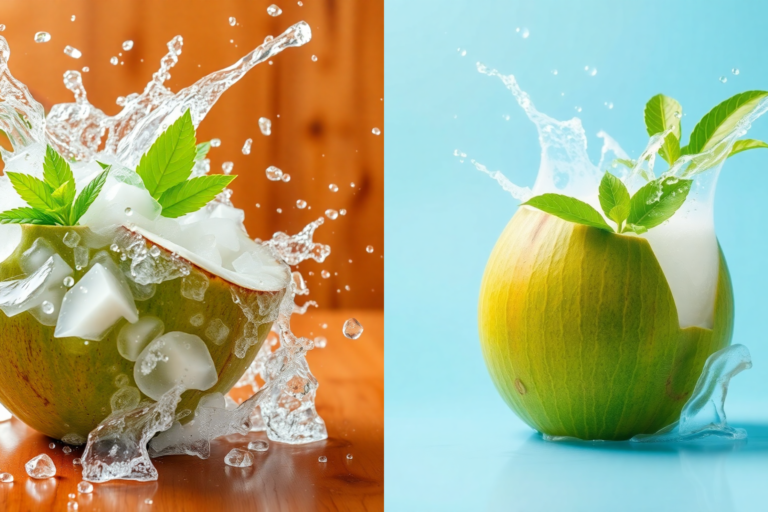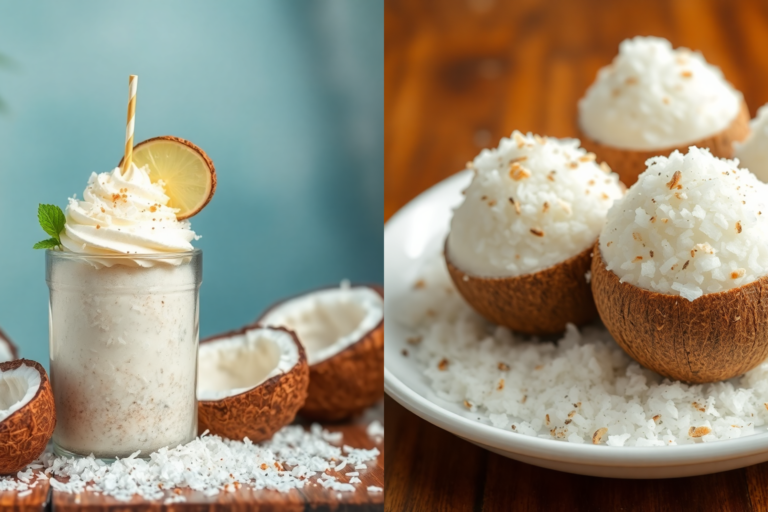
Introduction: Discovering the Delight of Desiccated Coconut
Desiccated coconut, a staple in many kitchens around the world, is made by finely shredding and drying the white meat of fresh coconuts. This process removes most of the moisture, resulting in a versatile ingredient that retains the rich, sweet, and nutty flavor of coconut. Desiccated coconut is loved for its unique texture and taste, making it a popular addition to a variety of dishes, from sweet desserts to savory entrees.
One of the key reasons for the popularity of desiccated coconut in cooking is its remarkable versatility. It can be used in baking to add texture and flavor to cakes, cookies, and bars. In savory dishes, it enriches curries, rice recipes, and salads with its distinctive taste and subtle sweetness. Even in beverages, desiccated coconut brings a delightful twist, making smoothies, cocktails, and teas more exotic and enjoyable.
In this blog post, we will explore the top 7 desiccated coconut recipes that you should try today. These recipes showcase the incredible versatility of desiccated coconut and provide a range of culinary delights, from sweet to savory. Whether you’re a seasoned cook or a beginner in the kitchen, these recipes are sure to inspire you to incorporate more desiccated coconut into your cooking repertoire.
Stay tuned as we dive into the delicious world of desiccated coconut with these top 7 recipes, each designed to highlight the unique qualities of this wonderful ingredient. From Coconut Macaroons to Thai Coconut Curry, these recipes will take your taste buds on a culinary adventure you won’t want to miss.
Recipe 1: Coconut Macaroons
Coconut macaroons are a delightful treat that combines the rich, tropical flavor of desiccated coconut with a sweet, chewy texture. These cookies are perfect for any occasion, easy to make, and guaranteed to satisfy your sweet tooth. Here’s a full detailed description of how to make the perfect coconut macaroons.
Ingredients List
- 2 1/2 cups desiccated coconut
- 1/2 cup sweetened condensed milk
- 1 teaspoon vanilla extract
- 2 large egg whites
- 1/4 teaspoon salt
Step-by-Step Instructions
Preheat the Oven: Start by preheating your oven to 325°F (165°C). Line a baking sheet with parchment paper to prevent the macaroons from sticking.
Mix the Coconut Base: In a large mixing bowl, combine the desiccated coconut, sweetened condensed milk, and vanilla extract. Stir until the mixture is well blended and the coconut is evenly coated with the condensed milk.
Beat the Egg Whites: In a separate, clean bowl, beat the egg whites and salt with an electric mixer on medium-high speed until stiff peaks form. This should take about 2-3 minutes.
Fold in the Egg Whites: Gently fold the beaten egg whites into the coconut mixture. Use a spatula to fold until just combined, being careful not to deflate the egg whites too much. This step ensures your macaroons are light and airy.
Shape the Macaroons: Using a small cookie scoop or a tablespoon, drop mounds of the coconut mixture onto the prepared baking sheet. Space them about an inch apart to allow for slight spreading.
Bake to Perfection: Place the baking sheet in the preheated oven and bake for 20-25 minutes, or until the macaroons are golden brown around the edges and slightly on top. Keep an eye on them to avoid over-browning.
Cool the Macaroons: Remove the baking sheet from the oven and let the macaroons cool on the sheet for a few minutes. Transfer them to a wire rack to cool completely. This helps them firm up and achieve the perfect texture.
Serving Suggestions and Tips
Dipping in Chocolate: For an extra indulgent treat, dip the bottoms of the cooled macaroons in melted dark or semi-sweet chocolate. Let the chocolate set by placing the dipped macaroons on parchment paper until firm.
Storage Tips: Store the coconut macaroons in an airtight container at room temperature for up to a week. For longer storage, you can freeze them in a single layer on a baking sheet, then transfer to a freezer-safe bag for up to three months. Thaw at room temperature before serving.
Flavor Variations: Add a twist to your macaroons by mixing in some finely chopped nuts, dried fruits, or a hint of almond extract. These variations can add interesting flavors and textures to the classic coconut macaroon.
Making coconut macaroons with desiccated coconut is a simple yet rewarding baking project. The combination of sweetened condensed milk and fluffy egg whites creates a cookie that is both chewy and light, with the desiccated coconut providing its signature tropical flavor and delightful crunch. Enjoy these macaroons as a sweet snack, a dessert, or even a gift for friends and family.
Coconut-Crusted Chicken Tenders: A Deliciously Crunchy Delight
Ingredients List for Coconut-Crusted Chicken Tenders
- 1 lb chicken tenders
- 1 cup desiccated coconut
- 1/2 cup panko breadcrumbs
- 2 large eggs
- 1/2 cup flour
- Salt and pepper to taste
- Cooking oil for frying
Step-by-Step Instructions for Coconut-Crusted Chicken Tenders
Prepare the Chicken:
- Start by seasoning the chicken tenders with salt and pepper on both sides. This will ensure the chicken is flavorful from the inside out.
Set Up the Breading Station:
- Arrange three shallow bowls for the breading process. Fill the first bowl with flour. In the second bowl, beat the eggs until they are smooth. In the third bowl, mix together the desiccated coconut and panko breadcrumbs.
Bread the Chicken:
- Take each chicken tender and first dredge it in the flour, shaking off any excess. Next, dip it into the beaten eggs, ensuring it is completely coated. Finally, roll the chicken tender in the desiccated coconut and panko breadcrumb mixture, pressing gently so the coating adheres well.
Heat the Oil:
- In a large skillet, heat about 1/4 inch of cooking oil over medium-high heat. To test if the oil is ready, drop a small piece of the breading mixture into the oil; it should sizzle immediately.
Fry the Chicken Tenders:
- Carefully place the breaded chicken tenders into the hot oil, making sure not to overcrowd the skillet. Fry the tenders in batches if necessary. Cook each side for about 3-4 minutes, or until the coating is golden brown and the chicken is cooked through.
Drain and Serve:
- Once the chicken tenders are fried to a perfect golden brown, remove them from the skillet and let them drain on a plate lined with paper towels. This will help remove any excess oil, keeping the tenders crispy.
Serving Suggestions and Tips for Coconut-Crusted Chicken Tenders
Serving Suggestions:
- Serve the coconut-crusted chicken tenders with a variety of dipping sauces such as sweet chili sauce, honey mustard, or a tangy yogurt dip.
- Pair these crispy tenders with a fresh, vibrant salad or a side of coconut rice to complement the tropical flavors.
- For a fun presentation, serve the chicken tenders on a platter garnished with lime wedges and fresh cilantro.
Tips for Perfect Coconut-Crusted Chicken Tenders:
- For an extra crunch, you can toast the desiccated coconut lightly before mixing it with the panko breadcrumbs.
- If you prefer baking over frying, place the breaded tenders on a baking sheet lined with parchment paper and bake in a preheated oven at 400°F (200°C) for about 20 minutes, flipping halfway through.
- To ensure the chicken tenders stay juicy, avoid overcooking them. Check for doneness by cutting into one of the thicker tenders to make sure the meat is no longer pink inside.
Incorporating desiccated coconut into your breading mixture not only adds a delicious flavor but also provides a beautiful, golden-brown crust that is sure to impress. Whether you’re serving these coconut-crusted chicken tenders at a family dinner or a casual get-together, they’re guaranteed to be a hit. Enjoy this delightful dish and explore the endless possibilities of cooking with desiccated coconut!
Recipe 3: Coconut Rice Pudding: A Creamy and Comforting Dessert
Ingredients for Coconut Rice Pudding:
- 1 cup Arborio rice
- 4 cups coconut milk
- 1/2 cup sugar
- 1 tsp vanilla extract
- 1/4 tsp salt
- 1/2 cup desiccated coconut
Step-by-Step Instructions for Coconut Rice Pudding:
Prepare the Rice: In a large saucepan, combine the Arborio rice, coconut milk, sugar, vanilla extract, and salt. Stir well to combine all the ingredients.
Cook the Mixture: Place the saucepan over medium heat and bring the mixture to a gentle boil, stirring occasionally to prevent the rice from sticking to the bottom of the pan.
Simmer and Stir: Once the mixture comes to a boil, reduce the heat to low and let it simmer. Stir the rice pudding frequently to ensure that the rice cooks evenly and doesn’t stick to the pan.
Add the Desiccated Coconut: As the rice pudding thickens and the rice becomes tender, add the desiccated coconut to the mixture. Stir well to incorporate the coconut into the pudding.
Check for Doneness: Continue to simmer the rice pudding until it reaches your desired consistency. The pudding should be creamy and thick, with the rice cooked through but still retaining a slight bite.
Remove from Heat: Once the rice pudding reaches the desired consistency, remove the saucepan from the heat. Let the pudding cool slightly before serving to allow it to thicken further.
Serving Suggestions and Tips for Coconut Rice Pudding:
Garnish and Serve: Serve the coconut rice pudding warm or chilled, garnished with a sprinkle of toasted desiccated coconut on top for added texture and flavor.
Pairings: Coconut rice pudding pairs wonderfully with fresh tropical fruits such as mango, pineapple, or passion fruit. The combination of creamy pudding and juicy fruit creates a delightful contrast of flavors and textures.
Storage Tips: Store any leftover coconut rice pudding in an airtight container in the refrigerator for up to three days. To reheat, simply warm the pudding gently on the stovetop or in the microwave, stirring occasionally to ensure even heating.
Customization: Feel free to customize the coconut rice pudding to suit your taste preferences. You can adjust the sweetness by adding more or less sugar, or experiment with different flavorings such as cinnamon, cardamom, or coconut extract.
Enjoy Anytime: Whether enjoyed as a comforting dessert after a hearty meal or as a sweet treat to satisfy your cravings, coconut rice pudding is sure to delight your taste buds with its creamy texture and tropical flavor.
Recipe 4: Coconut and Mango Smoothie
Incorporating the delightful flavors of coconut and mango, this smoothie is a tropical delight that will transport your taste buds to paradise. Packed with nutrients and bursting with freshness, it’s the perfect way to start your day or enjoy as a refreshing snack any time.
Ingredients List:
To whip up this tropical treat, you’ll need the following ingredients:
- 1 cup frozen mango chunks
- 1/2 cup coconut milk
- 1/2 cup plain yogurt
- 2 tbsp desiccated coconut
- 1 tbsp honey (optional)
- Ice cubes (optional)
These simple yet flavorful ingredients come together harmoniously to create a smoothie that’s both creamy and refreshing.
Step-by-Step Instructions:
Now, let’s dive into the steps to make this delicious Coconut and Mango Smoothie:
Prepare Your Ingredients: Gather all your ingredients and ensure your blender is ready to go.
Combine the Ingredients: In the blender, add the frozen mango chunks, coconut milk, plain yogurt, and desiccated coconut. If you prefer a sweeter smoothie, add honey to taste.
Blend Until Smooth: Secure the lid on your blender and blend on high speed until the mixture is smooth and creamy. If you prefer a thicker consistency, you can add a handful of ice cubes before blending.
Taste and Adjust: Once blended, taste the smoothie and adjust the sweetness or thickness to your liking. Add more honey if desired for sweetness or more coconut milk for a thinner consistency.
Serve and Enjoy: Pour the smoothie into glasses and garnish with a sprinkle of desiccated coconut for an extra tropical touch. Serve immediately and enjoy the refreshing flavors of coconut and mango.
Serving Suggestions and Tips:
Here are some serving suggestions and tips to enhance your Coconut and Mango Smoothie experience:
- Garnish with Fresh Fruit: For an added burst of freshness and visual appeal, garnish your smoothie with slices of fresh mango or a wedge of lime.
- Adjust Sweetness to Taste: The sweetness of the smoothie can vary depending on the ripeness of the mango and your personal preference. Taste the smoothie before serving and adjust the sweetness by adding more honey if needed.
- Experiment with Add-Ins: Get creative and customize your smoothie by adding other ingredients such as spinach for added nutrients, a splash of orange juice for extra tanginess, or a scoop of protein powder for a post-workout boost.
- Make it Creamier: For an even creamier texture, substitute some of the coconut milk with coconut cream or add a ripe banana to the blender.
- Serve Chilled: For the most refreshing experience, chill your ingredients beforehand and serve the smoothie immediately after blending.
With these serving suggestions and tips, you can elevate your Coconut and Mango Smoothie to new heights of tropical deliciousness. Whether enjoyed as a breakfast on-the-go, a post-workout refuel, or a satisfying snack, this smoothie is sure to brighten your day with its sunny flavors and creamy texture. Cheers to tropical indulgence!
Recipe 5: Coconut Energy Balls
Elevate Your Snack Game with Coconut Energy Balls
In the hustle and bustle of daily life, having a nutritious and energizing snack on hand is essential. These Coconut Energy Balls are not only packed with wholesome ingredients but also bursting with flavor, making them the perfect pick-me-up for any time of day. Let’s dive into how to whip up a batch of these delightful treats.
Ingredients List
Gathering the ingredients for Coconut Energy Balls is a breeze, and you likely have most of them in your pantry already. Here’s what you’ll need:
- 1 cup rolled oats
- 1/2 cup desiccated coconut
- 1/2 cup almond butter
- 1/4 cup honey
- 1/4 cup dark chocolate chips
- 1 tsp vanilla extract
- Pinch of salt
Step-by-Step Instructions
Making these Coconut Energy Balls is a simple and enjoyable process. Follow these steps to create your own batch:
Combine Dry Ingredients: In a large bowl, mix together the rolled oats and desiccated coconut until evenly combined.
Add Wet Ingredients: Add the almond butter, honey, vanilla extract, and a pinch of salt to the bowl with the dry ingredients.
Mix Thoroughly: Using a spoon or your hands, mix all the ingredients together until a sticky dough forms.
Incorporate Chocolate Chips: Gently fold in the dark chocolate chips, ensuring they are evenly distributed throughout the dough.
Shape into Balls: Take small portions of the dough and roll them between your palms to form bite-sized balls. Repeat until all the dough is used.
Chill: Place the energy balls on a baking sheet lined with parchment paper and chill in the refrigerator for at least 30 minutes to firm up.
Serving Suggestions and Tips
Once your Coconut Energy Balls are ready, it’s time to enjoy them to the fullest. Here are some serving suggestions and tips to make the most of this nutritious snack:
On-the-Go Snack: Pack a few Coconut Energy Balls in a small container or zip-top bag for a convenient snack to enjoy on-the-go. They’re perfect for busy days or as a post-workout refuel.
Pairing Possibilities: These energy balls pair well with a variety of beverages, such as a refreshing glass of almond milk or a cup of hot tea. Experiment with different combinations to find your favorite pairing.
Storage Solutions: Store any leftover Coconut Energy Balls in an airtight container in the refrigerator for up to a week. They can also be frozen for longer storage, simply thaw them in the refrigerator before enjoying.
Customization Options: Feel free to customize the recipe to suit your preferences. Swap almond butter for peanut butter, add dried fruit or nuts for extra texture, or drizzle melted chocolate over the top for a decadent touch.
With their delicious flavor and nourishing ingredients, these Coconut Energy Balls are sure to become a favorite snack in your household. Whip up a batch today and experience the natural energy boost they provide.
Recipe 6: Thai Coconut Curry: A Taste of Southeast Asia
Ingredients for Authentic Flavor
Creating an authentic Thai coconut curry requires a blend of key ingredients that capture the essence of Southeast Asian cuisine. Here’s what you’ll need:
- 1 tablespoon vegetable oil
- 1 onion, chopped
- 2 garlic cloves, minced
- 1 tablespoon ginger, minced
- 2 tablespoons red curry paste
- 1 can (14 ounces) coconut milk
- 1 cup vegetable broth
- 1 bell pepper, sliced
- 1 zucchini, sliced
- 1 cup desiccated coconut
- Salt and pepper to taste
- Fresh cilantro for garnish
Step-by-Step Instructions: Bringing Thai Flavors to Your Table
Prepare the Aromatics: Heat vegetable oil in a large pot over medium heat. Add chopped onion, minced garlic, and minced ginger, sautéing until fragrant and translucent, infusing the base of your curry with layers of flavor.
Infuse with Spice: Stir in the red curry paste, allowing it to bloom in the oil for a minute, releasing its aromatic spices and vibrant color.
Creamy Coconut Base: Pour in the creamy richness of coconut milk, followed by the vegetable broth, creating a velvety sauce that will envelop your ingredients in Thai-inspired goodness.
Add Vegetables: Introduce the vibrant colors and textures of sliced bell pepper and zucchini, allowing them to simmer until tender yet still crisp, soaking up the flavors of the curry.
The Final Touch: Incorporate the star of the dish—desiccated coconut, adding depth and texture to your curry while subtly enhancing its coconut undertones.
Season to Perfection: Season with salt and pepper to taste, ensuring the flavors are perfectly balanced to tantalize your taste buds.
Garnish and Serve: Finish your Thai coconut curry with a flourish of fresh cilantro, adding a pop of color and a burst of freshness to each serving.
Serving Suggestions and Tips: Elevating Your Dining Experience
Pairing Perfection: Serve your fragrant Thai coconut curry over a mound of jasmine rice, the perfect canvas to soak up the luscious sauce and complement the bold flavors of the dish.
Accompaniments with a Twist: Enhance your culinary adventure by serving your curry with traditional Thai condiments such as sliced lime, chopped peanuts, and fresh chili peppers, allowing diners to customize their experience to their taste preferences.
Storing for Later: If you find yourself with leftovers, store your curry in an airtight container in the refrigerator for up to three days, allowing the flavors to meld and intensify for a delicious encore performance.
Immerse yourself in the tantalizing flavors of Southeast Asia with this authentic Thai coconut curry recipe. Whether enjoyed as a comforting weeknight meal or showcased as the star of your next dinner party, this dish is sure to transport your taste buds to the bustling streets of Bangkok with every savory spoonful.
Recipe 7: Coconut Banana Bread
Ingredients for Delicious Coconut Banana Bread
For this mouthwatering coconut banana bread, you’ll need:
- 1 1/2 cups all-purpose flour
- 1 teaspoon baking soda
- 1/2 teaspoon salt
- 1/2 cup unsalted butter, softened
- 1 cup granulated sugar
- 2 large eggs
- 1 teaspoon vanilla extract
- 1/2 cup sour cream
- 1 cup mashed ripe bananas (about 2-3 bananas)
- 1/2 cup desiccated coconut
Step-by-Step Instructions for Baking Coconut Banana Bread
Preheat and Prepare: Start by preheating your oven to 350°F (175°C). Grease a standard loaf pan with butter or non-stick spray and set it aside.
Combine Dry Ingredients: In a medium-sized bowl, whisk together the all-purpose flour, baking soda, and salt until well combined. Set this dry mixture aside for later use.
Cream Butter and Sugar: In a large mixing bowl, cream together the softened butter and granulated sugar until light and fluffy. This can be easily achieved using a handheld or stand mixer.
Add Wet Ingredients: Once the butter and sugar are creamed, add in the eggs one at a time, beating well after each addition. Then, mix in the vanilla extract and sour cream until fully incorporated.
Incorporate Bananas and Coconut: Gently fold the mashed ripe bananas and desiccated coconut into the wet mixture until evenly distributed. The mashed bananas will add moisture and sweetness, while the desiccated coconut will infuse the bread with a delightful tropical flavor.
Combine Wet and Dry Mixtures: Gradually add the dry flour mixture into the wet ingredients, stirring until just combined. Be careful not to overmix, as this can result in a tough banana bread texture.
Transfer to Loaf Pan: Pour the batter into the prepared loaf pan, spreading it out evenly with a spatula.
Bake to Perfection: Place the loaf pan in the preheated oven and bake for 60-70 minutes, or until a toothpick inserted into the center comes out clean. The top should be golden brown and the edges slightly pulling away from the sides of the pan.
Cool and Serve: Once baked, remove the coconut banana bread from the oven and allow it to cool in the pan for 10 minutes. Then, carefully transfer it to a wire rack to cool completely before slicing.
Serving Suggestions and Tips for Perfect Coconut Banana Bread
Serve Warm or Toasted: Enjoy slices of coconut banana bread warm straight from the oven, or lightly toast them for a crispy exterior and warm, fluffy interior.
Pair with Your Favorite Spread: Spread a generous layer of butter or cream cheese on a slice of coconut banana bread for an extra indulgent treat.
Store Properly: Store any leftover coconut banana bread in an airtight container at room temperature for up to 5 days. For longer storage, wrap slices tightly in plastic wrap and freeze for up to 3 months.
Enhance with Nuts or Chocolate: For added texture and flavor, consider mixing chopped nuts or chocolate chips into the batter before baking. Walnuts, pecans, or dark chocolate chunks would complement the coconut and banana beautifully.
Indulge in the delightful flavors of this coconut banana bread, perfect for breakfast, snacking, or dessert. Whether enjoyed on its own or paired with your favorite toppings, this moist and flavorful bread is sure to become a family favorite.
Tips for Cooking with Desiccated Coconut
Incorporating desiccated coconut into your culinary creations can add a delightful tropical flavor and texture. Here are some best practices to ensure you make the most of this versatile ingredient and keep it fresh for future use.
Best Practices for Incorporating Desiccated Coconut into Various Dishes
When using desiccated coconut in your recipes, consider the following tips to achieve the best results:
Toasting for Enhanced Flavor: Toasting desiccated coconut before adding it to your dishes can intensify its flavor and add a pleasant crunch. Simply spread the coconut in a single layer on a baking sheet and bake in a preheated oven at 325°F (165°C) for 5-7 minutes, stirring occasionally, until golden brown.
Balancing Moisture: Desiccated coconut has a natural tendency to absorb moisture from its surroundings, which can affect the texture of your dishes. To prevent this, consider adjusting the moisture content in your recipes or adding desiccated coconut towards the end of the cooking process.
Pairing with Complementary Ingredients: Desiccated coconut pairs well with a variety of flavors, including tropical fruits, chocolate, nuts, and spices like cinnamon and cardamom. Experiment with different combinations to discover new and exciting flavor profiles.
Texture Enhancement: Whether you’re baking cookies, blending smoothies, or preparing curries, desiccated coconut can enhance the texture of your dishes by adding a chewy or crunchy element. Be mindful of the desired texture and adjust the quantity of desiccated coconut accordingly.
Creative Uses: Don’t limit yourself to traditional recipes when cooking with desiccated coconut. Get creative and incorporate it into unexpected dishes such as salads, granola bars, and even savory sauces for a unique twist.
Storage Tips to Maintain Freshness and Flavor
Proper storage is essential for preserving the freshness and flavor of desiccated coconut. Follow these tips to ensure your coconut remains at its best:
Airtight Containers: Transfer desiccated coconut to an airtight container or resealable plastic bag to protect it from exposure to air, moisture, and odors. Ensure the container is tightly sealed to prevent any external contaminants from affecting the quality of the coconut.
Cool, Dry Location: Store the sealed container of desiccated coconut in a cool, dry place away from direct sunlight, such as a pantry or cupboard. Avoid storing it near sources of heat or humidity, as these can accelerate spoilage and affect the flavor of the coconut.
Refrigeration or Freezing: While desiccated coconut does not require refrigeration, storing it in the refrigerator or freezer can extend its shelf life. If you anticipate not using the coconut for an extended period, consider freezing it in a freezer-safe container to maintain its freshness for several months.
Check for Signs of Spoilage: Periodically inspect your stored desiccated coconut for any signs of spoilage, such as a rancid odor, mold growth, or changes in color or texture. Discard any coconut that appears to be spoiled, as consuming it could lead to foodborne illness.
By following these best practices for incorporating desiccated coconut into your dishes and storing it properly, you can enjoy its delicious flavor and texture in your culinary creations for longer periods. Experiment with different recipes and techniques to discover new ways to elevate your cooking with this versatile ingredient.
Conclusion: Embrace the Versatility of Desiccated Coconut
Recap of the Versatility and Deliciousness of Desiccated Coconut
Desiccated coconut, with its rich flavor and satisfying texture, has proven itself to be a culinary powerhouse throughout this blog post. From the delicate sweetness it brings to coconut macaroons to the savory crunch it adds to coconut-crusted chicken tenders, its versatility knows no bounds. Whether you’re whipping up a tropical smoothie or simmering a fragrant Thai curry, desiccated coconut is there to elevate your dishes and transport your taste buds to paradise.
Encouragement to Try the Recipes and Share Experiences
Now that you’ve glimpsed into the world of desiccated coconut’s culinary mastery, it’s time to roll up your sleeves and dive into these mouthwatering recipes. Don’t be afraid to experiment and make these dishes your own. Share your experiences with friends and family, and let the aroma of coconut-infused creations fill your kitchen with warmth and joy. Whether you’re a seasoned chef or a kitchen novice, there’s something here for everyone to enjoy.
Explore a variety of delicious recipes featuring desiccated coconut. Feel free to visit and discover new culinary delights!
https://www.yummytummyaarthi.com/homemade-desiccated-coconut-recipe-how/
https://www.bbcgoodfood.com/recipes/collection/desiccated-coconut-recipes










